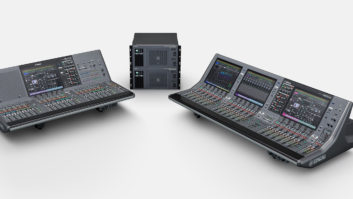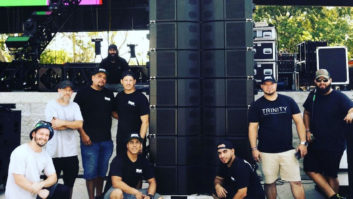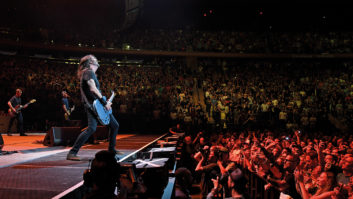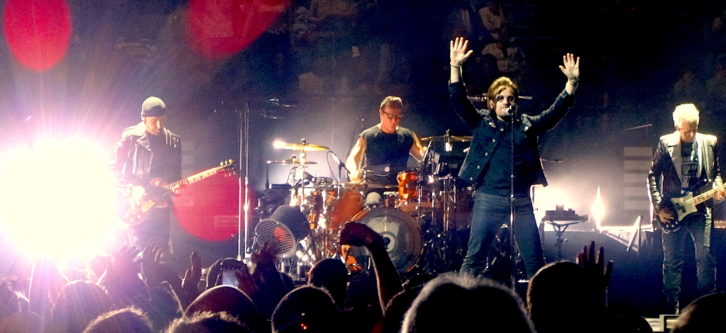
“The end of September 1978 was my first show with U2,” muses Joe O’Herlihy, the band’s sound director. We’re standing on stage an hour before the Irish rockers are due to go on, but while I’m at Nassau Veterans Memorial Coliseum in Uniondale, NY, for a brief moment, O’Herlihy is back at the Arcadia Ballroom in Cork 40 years ago. “I worked with an Irish guitar player, Rory Gallagher, from ’73 to ’78; I actually had just finished my stint and decided I was coming home. Then I met U2 about three weeks later, and off I went again! The rest is history.”
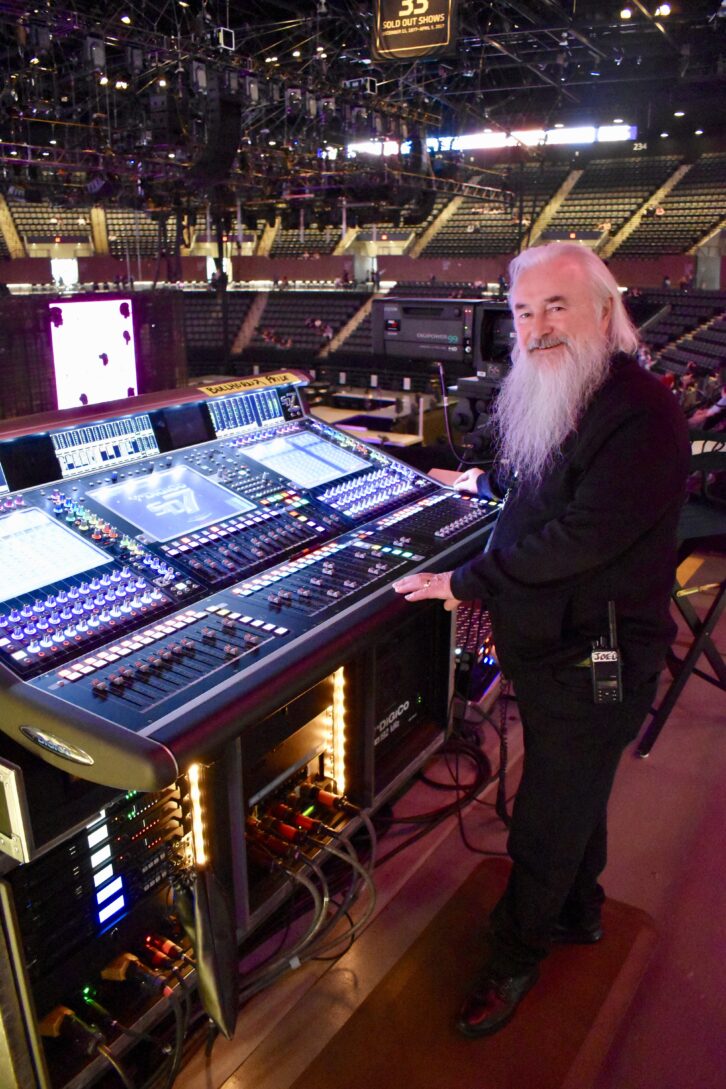
The ensuing four decades provided much of the subject matter for U2’s current arena jaunt, which finishes off a triptych of tours that are conceptually ambitious even for a band that regularly aims for epic. The 76-show Innocence + Experience world arena tour in 2015 presented a loosely autobiographical show that examined U2’s life as “innocent” teens in a band. Then 2017 saw the group return to stadiums for 51 shows on The Joshua Tree tour, marking the 30th anniversary of its namesake album (and conceptually, the point where the band gained experience). Now 2018 bookends the project with the Experience and Innocence tour, which thematically wrestles with the pitfalls of worldliness.
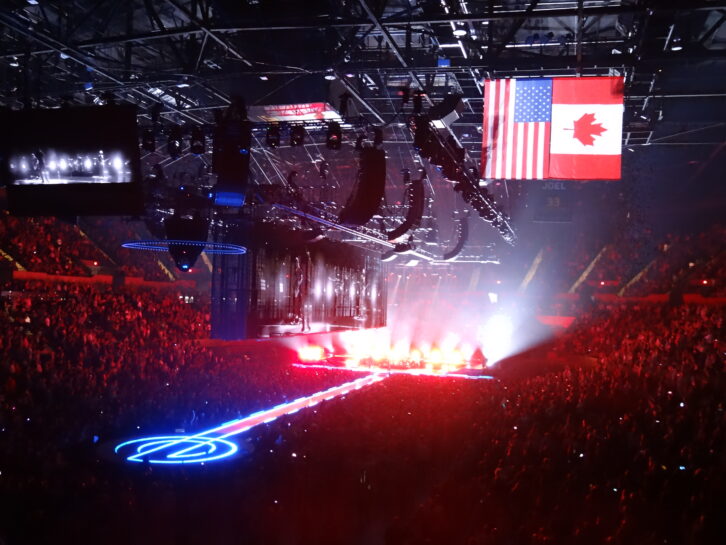
If it sounds heavy, it sometimes is, but not as heavy as the massive amount of production that goes into the show every night. Once again, the band’s audio needs are being handled by Clair Global. The show’s visual trademark—much as it was for the 2015 tour—is the unusual staging that allows the band to perform across the length of the arena floor, giving all fans a chance to momentarily have the best seats in the house. A main stage at one end leads to a runway that cuts lengthwise down the venue to the other end’s circular B-stage, dubbed “the E stage”—as in “Experience.” Above the runway hangs a massive, double-sided screen (initially called The Divider, now nicknamed The Barricage) that shows video to both halves of the venue, even as it occasionally comes apart or presents bandmembers climbing around inside it mid-song.
The challenge for O’Herlihy was to present sound as the band performs at various positions across the length of the venue; the answer was to create an oval ring of 12 alternating left-right Clair Cohesion CO-12 PA hangs above the perimeter of the arena floor, each backed by eight hangs of three Cohesion CP-218 SUBS that use the cardioid method for steering the bass energy into the arena. “It’s a stereo image all the way around the entire building, so you’ve always got a stereo image, no matter where you are,” says O’Herlihy. “The beauty of all of this is that each cabinet is within 75 feet of the listening public; it’s very close, but the system is never under stress, so the quality of audio is 1,000 percent, simply because the system is focused for specific distribution to specific areas. It also never gets that loud; if it does, come and smack me.”
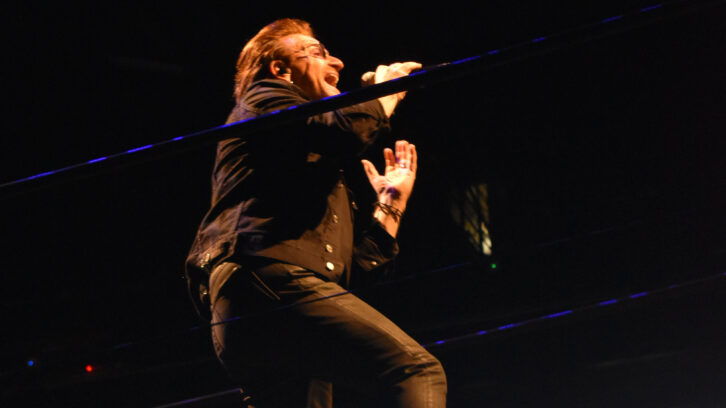
Covering fans on the general admission floor are 32 Cohesion CO-10s used for downfill and centerfill above the front of the main stage, runway and E stage, and 18 CO-8s are built into the staging and runway as well. “All the way down, there’s a speaker four feet away from you,” says O’Herlihy. “The intensity of its level is time-aligned automatically so it gives you the impression of the sound; if Bono is standing there singing, he’s singing to you. I think what it does is create interactivity, and this band is all about communicating with the audience. If they can’t do that, then it defeats the purpose; the whole thing is connectivity.”
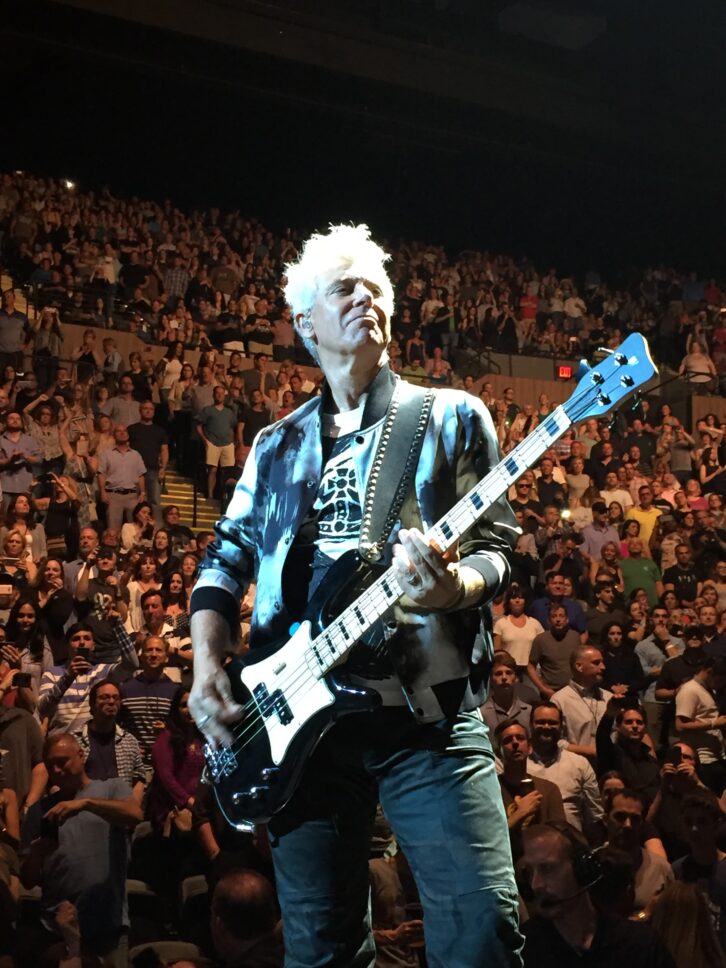
Because the system is designed to provide omnipresent audio, the FOH position can be placed virtually anywhere in the venue, so long as it’s relatively equidistant between two CO-12 hangs. As a result, FOH tends to be a few tiers up in the stands amidst the audience, allowing O’Herlihy to hear what the crowd hears and also gain a much-needed bird’s eye view of a show that traverses the length of the room. Central to the FOH area is a DiGiCo SD7 console, one of eight on the tour, all of which run at 96k. While O’Herlihy has no issue with effect emulations and plug-ins, he opts to use two racks packed with Manley VoxBoxes, Avalon VT-737s, Summit Audio DCL200 and more vintage units from TC Electronic, Yamaha, Lexicon and others—simply because he can.
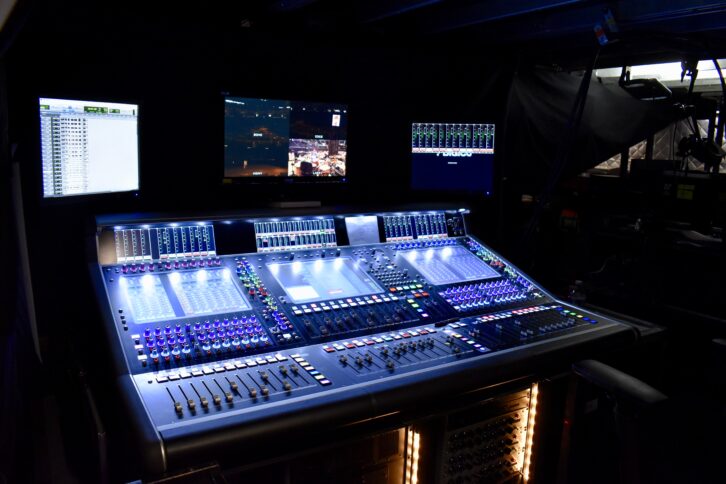
A massive monitorworld sits beneath the stage, comprised of Niall Slevin’s RF base, centered around a slew of Sennheiser wireless systems, and DiGiCo desks used variously by Alastair McMillan (mixing for Bono), CJ Eriksson (Larry Mullen and Adam Clayton), and Richard Rainey (the Edge) as they follow the show via video monitors tracking each bandmember.
“Each console has 128 inputs and we’re not duplicating anything,” says O’Herlihy. “When they’re on the E stage, certain channels are used; when they come into the Barricage, there’s another separate set of channels that are used; and the mainstage has its own channels. We don’t complicate anything by duplication; when you duplicate, you multiply your own chances of error by doing so! Also, we believe in 100 percent redundancy; that’s why we use the DiGiCo SD7. There’s two engines in each of the consoles, so if you have failure in one engine, it automatically switches to the other one because they run concurrently. Even the most educated ear wouldn’t hear the change. It is a huge aspect of what we do—biggest tour in the world, nothing can go wrong—so that’s why we use this particular product.”
The consoles, 200-plus loudspeakers and everything else from Clair Global are a far cry from the band’s early days with the audio provider. “We’ve been doing this for a long, long time,” O’Herlihy admits, “and it’s incredible the relationship that we have with Clair going back. Our 35th anniversary was on the 11th of May—the first show we did with them was The Palladium in New York. We were playing in Las Vegas on the night, and I sent them a note, saying ‘Congratulations, guys; 35 years ago today! I’d just like to share this with you.’ Loads of notes back—Dave Skaff said, ‘I remember driving some extra gear up to New York,’ and Troy Clair chimes in, ‘I remember loading the truck for that!’—and he’s the president/CEO of the company now.
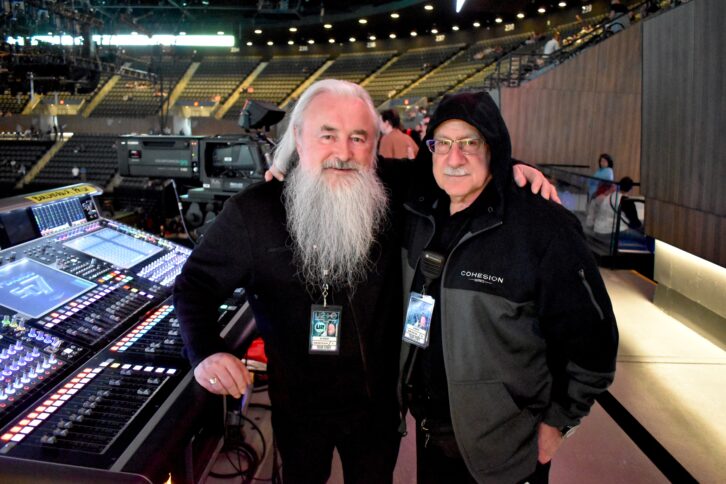
“And that’s the thing—it’s so much about the people. You can have the best kit in the world, but kit is kit if you don’t have the understanding of the people that are behind it. We do this for two hours every day; there’s 22 hours in the rest of the day, so people have to get on with each other, they have to travel in a bus, they have to do that whole thing—and your tour lasts! A lot of the people here have been with me a long, long time. Joe Ravitch, our senior systems engineer, has been with me 35 years—since that Palladium gig actually.”
If a U2 tour sounds a bit like a family affair, make no mistake: It is. “My daughter Sarah is out here, working in tour management,” he reports. Motioning to the Barricage, he adds, “My son, Mark, that’s his screen. He works for PRG in Los Angeles where he’s our video provider. He came out with us in 1990 and he’s been providing the video ever since. Sarah grew up around the guys; we were actually at Park West in Chicago, the 12th of April, 1981, when she was born [during] the U2 tour, so they know her since she was knee-high to a grasshopper, as they say.”
Still, after 40 years of mixing U2, with productions, technologies, children and expectations that have all grown over the years, how does he see his work today?
“Do you know what?” says O’Herlihy. “I’ve got the greatest job in the world. I wake up every day, I love what I do. How many people get up every day and hate what they do? I am absolutely blessed and I know it—and that’s how I feel about it every day.” That sounds like the voice of Experience.
Clair Global • www.clairglobal.com
DiGiCo • www.digico.biz


